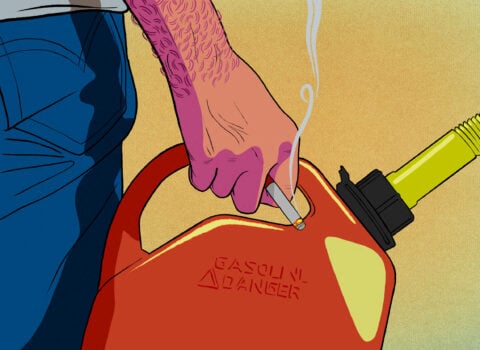My first skis, at age two, were Olin brand, a fluorescent coral pink. They had no edges. Their sidewalls were pure white, like cut cake. They glowed, a special and unearthly light source in the snow. I was pulled along an almost flat hill, holding the end of my mother’s ski pole.
At three, not good enough yet to ski with my parents and older brother, I was left at the rope tow. At four, graduated to skis with metal edges and able to scooch onto the bunny lift, I continued to fend for myself. I would sometimes wait at the bottom for a very long time, too shy to yell “single.” I remember falling while loading, and then a grown-up man skied over my face by accident as he got on. I nursed a split lip in the lodge, standing before the coin-op donut machine, watching fresh batter drop into boiling grease. I was fascinated by those donuts. We never ate one. We never bought any food at ski areas and were sometimes chased from the lodge for sneaking in our bagged lunch. This was at Oregon’s Mount Bachelor, our home mountain, where a family pass, as my father recalls, was $67 a year.
My earliest memory of skiing deep powder, at age five or six, was on the cinder cone at Bachelor, which had no lift. Only those seeking precious turns in new snow bothered to sidestep or bootpack their way up. This is where I learned to “garland” turns along my father’s tracks, mirroring them to form a woven pattern down the fall line. At the base of the cinder cone was a crown of low evergreens. We skied into them, whooping.
Alpine skiing, Jean-Paul Sartre wrote in 1943, is “compromised” by such garlands, made “less perfect” by any trace a skier leaves behind. Sartre and Simone de Beauvoir had taken a series of trips to the Alps starting in the winter of 1934. They were beginners. Sartre’s strabismal eye wouldn’t have aided his balance, but skiing can almost never be mastered in adulthood anyhow, which might account for Sartre’s inability to value the trace. The trace is proof a skier took the fall line, proof the skier connected turns through tight trees in untracked pow, by which I mean powder, by which I mean, as The New Yorker has insisted on calling it, but no expert skier ever would, “powder snow.”
Still, Sartre’s inclination to philosophize skiing is deeply charming. Sport, he argues, is a form of “doing” that conscripts a worldly environment—an expanse of snow, say—into a “supporting element” for human action. Meanwhile, this expanse should bear no human scars, and instead remain “in-itself.” He treats skiing with an ontological importance few have given it. Few, that is, besides Martin Heidegger, who wore his ski suit to teach in Freiburg after spending the morning making turns near his Black Forest hut.
Children make snowballs, Sartre says, to submit the blank matter of snow to human form. He refers to snow as an “absolute nudity of substance.” He compares it to a woman’s body, “which the caress leaves intact.” I thought I knew Sartre’s commentary on skiing well. But I’d forgotten about this business of the nude body. I’m guessing Norman Mailer must have read this passage, which appears in Being and Nothingness. He summons it almost explicitly in a journal entry from 1954, while gazing at his wife Adele’s body: “I realized suddenly how close a woman’s body is to a ski slope.” The great skier, he muses, is sexually frustrated and needs triumph, “hence he rides like a charioteer over a ski slope, a giant ascetic woman open to his fury.”
Not a great skier himself, Mailer is trying to decode the secret of the skier’s drive. He’s a man of his time, and he’s Mailer: it would be dull and easy to attack him, and also Sartre, for thinking that skiing has to do with masculinity, for approaching it as metaphor. James Salter, who likewise revered skiing but was not an expert, nevertheless somehow understood what skiing is, as a state of being, and what it isn’t. Skiing, for Salter, is not about men, but it does have at its core an ambiguity, one that is illustrated beautifully in Downhill Racer, whose script he wrote. The racer, played by Robert Redford, is selfish and arrogant. He wants to win. Second to winning, he wants a woman (she launches off cornices and drives a Porsche 911 with a ski rack). He doesn’t get her (she’s as calculating as he is), but he does win. And yet the glory, the sudden approval of his coach, the crowd that surrounds him, leaves him cold. The existential kernel at the heart of this subdued film goes beyond ski racing: it’s about the skier as a divided subject, unable to square doing (plunged into, at one with) and being (alienated, at a remove), and how different kinesthetic gifts are from conscious thought.
It’s luck, not character, that I’ve been skiing for half a century. I was born into it. I’m tempted to say my parents were ski bums, but they didn’t forgo intellectual pursuits to ski, which is the ski bum’s sacrifice. They were graduate students who found a way to ski on the cheap. My father had begun working in a ski shop at age fourteen. At Dartmouth, he joined the ski team. My early childhood was spent in Eugene, Oregon, not far from Bend, where we parked our converted school bus in the winter for access to Bachelor. In the spring of 1968, my mother stayed in the bus and skied every day, pregnant with me, while my father hitchhiked to Sun Valley, Idaho, to see Jean-Claude Killy ski. He got a ride with a chicken farmer (feathers everywhere), did course prep for a free lift ticket, and watched Killy win.
Every December, we drove up to British Columbia to ski at Whistler with our friends Peter and Nona Rowat and their two daughters. The Rowats did not buy tickets. They hiked up beyond the midway station, where they weren’t checked, their husky, Taku, barking and bounding ahead. One winter, all eight of us plus Taku stayed in a crude trapper’s hut with no heat, electricity, or running water. It had a dirt floor. The toilet was a shed over a hole in the ground. Peter Rowat cut cedar boughs and stuffed them in the hole to improve the smell. We used Coleman lanterns and bundled up—normal to us from life in the bus. One night, a man barged in. I remember him as a kind of snow tramp. He said he planned to stay. That would make us nine people and a large dog in one room. It was a tense scene. Nobody remembers quite how it resolved. But most of that trip was happy. Several feet of snow fell. We consented to the raw-food diet the Rowats insisted on, and in exchange, they tolerated my parents’ few bottles of beer.
Some years we drove to Utah to ski at Snowbird, a new area whose tram offered the chance for a lot of vertical in one day. In 1977, we spent a month at a cruddy motel in Salt Lake City next to a Marie Callender’s and drove up to Snowbird every day. My brother and I slept on the floor, with towels stuffed under the door to block the cold air. One afternoon, we signed up to learn about “time-share condominiums,” because doing so promised dinner at the Steak Pit, at the base of Snowbird. The long evening we spent pretending we were going to buy a time-share yielded one steak dinner split four ways. I didn’t understand that the whole thing was a ruse to get free food, and for several hours excitedly believed my future involved this condo with plush carpeting, a kitchen with different colored pastas in glass jars, but there was no condo in our plans: we were dirtbag skiers.
As a college freshman, I joined the Dirt Bag Ski Team at Berkeley, as the team called itself, having emblazoned this on the side of a Winnebago after making it to nationals the year before. There was heavy drinking. Also, Skoal wintergreen, long cut. We got free season passes, pro-deal skis, and a place to stay. We skied Thursdays to Mondays. Another school in our league, Sierra Nevada College, began recruiting from the Yugoslavian national team. Their slalom suits said jug down the leg. Their top women were beating our men. We took it with good humor. If you’re pursuing a career ski racing, you go to a Division I NCAA school. Berkeley was NSCA (now USCSA), a lesser league. Our team attracted cerebral people who happened to have a racing background. Some of us were freeskiers at heart. Our captain told freshmen to drink a case of beer and go ski off cliffs. It was a joke, and not a joke. The edge of control is what you want to locate on the racecourse. My third year, the seminal Greg Stump ski movie The Blizzard of Aahhh’s came out. We put in the VHS tape every morning before running gates. My teammate Bob Maze, from Taos, New Mexico, could do a tip roll as elegant as its star, the newly famous “extreme skier” Glen Plake. One night, some of the guys looked up Plake in the South Lake Tahoe phone book. His dad, a local ski instructor, answered the phone. “Glen is not here,” he said. “Tell him we love him.”
Glen Plake still skis, though he lacerated his liver on his ski pole, as documented in a sequel to The Blizzard of Aahhh’s. I often bring this up to my son, Remy, as a comic reminder to stay sensible. Remy is fourteen. When he was six, we lived for a year in Ithaca, New York. Every weekend I took him to train with the Greek Peak race program. His first day, it poured rain. The kids had to take breaks to wring out their jackets and pants. Greek Peak is low, at 2,100 feet. The lift operators smoked cigarettes and donned hard hats. There were recreational skiers in hunting apparel, no goggles. I romanticized the modesty, but I was relieved to return to California and Mammoth Mountain, which is driving distance from my house and more than five times the height of humble Greek Peak.
I’ve been skiing at Mammoth now for twenty-two years, with my friend Benjamin Weissman, an artist and writer who has a cabin there. Ben knows every line and secret stash on the mountain, having learned from the “core bros,” the locals. I ski with Ben and Remy and sometimes our friend John Wentworth, who has been known to answer his door dressed like Peter Sellers playing Clare Quilty in Kubrick’s Lolita, and to suddenly speak only French while venturing out of bounds to Hole in the Wall, a natural rock formation we ski through to a road where we hitchhike home.
At a certain point in my twenties, before I met Ben, I could no longer tolerate ski culture. So much time with the ski team had burned me out. That realm was bro talk, gear talk, and it excluded too much of the world, and too much of interiority. It still is like that. It reaches new heights in Teton Gravity Research movies, which feature incredible skiers pondering, idiotically, the meanings of “stoke” and “dude.” I’m not threatened by that now. What bothered me, long ago, was the way this dumbing down drew my attention to an internal conflict between mind and body, between thought, the desire to do something creative with my life, and skiing, which came naturally, but excluded art and literature. I could hang with the ski bums, but they were a mirror of what I didn’t want to be. This conflict resolved itself on a life-changing trip with Ben and the artist Peter Doig, who, like Ben, is a fast and strong skier. We were a team, tearing around the mountain, but bantering in the gondola about, say, the pop artist Eduardo Paolozzi, or being quiet, tending to our inner selves. (Some of Doig’s paintings, I came to later understand, are like scenes through snowy goggles.) Skiing, I decided on that trip, could be strange and various, hilarious, with no compromise in speed or steeps.
It could be that the environment of the ski hut coaxes ideas, not all of them useful (cue Heidegger), though I was told Scandinavian prison abolition was born in one, in Norway, in the early Seventies. And if the hut is a crucible, maybe something permanent was forged in each of us children in that trapper’s lair in British Columbia: the understanding that part of us would forever be located not in our thoughts, but out there, in uncontrolled winter. This is not a division of the subject, but a unity of the subject. I’m here, and I’m in the clouds, or among snow-loaded branches.
On stormy days, whenever I catch a glimpse of that Day-Glo shade of my little Olin skis against the reflective white of snow, I am plunged into sense-memory. The feeling it gives me is of a home on skis, an orientation I possess even when visibility is replaced by an opaque veil of blowing snow, a home deep inside myself while the wind whips.
Skis are everything to the skier. There is almost no scenario in which I’d intentionally remove mine on the hill. Even hip-sliding off a six-foot berm to the street to return to the cabin, I keep my skis on. I rely on them as a natural (but unnatural) extension of body. After I outgrew my Olin “baby” skis, they were given to the younger Rowat daughter, Lena, but her mother, Nona, stepped on them by accident and they broke. I remember Lena as not eager to ski, as delicate and sickly. I see her in a flowered nightdress, a toddler stricken with mumps, her blond hair floating in the staticky winter air. I mostly skied with her older sister, Ruby, petite, dark-haired, strong-willed, who later became a professional trapeze artist.
All these decades since, while I have been doing and being, while I have been skiing, it turns out that Lena has, too. I haven’t seen her since we were kids. But I hear news. She’s six feet tall. She lost her lover to an avalanche. And she’s the only person ever to complete a ski traverse from Vancouver to Alaska across the Coast Mountain Range, then to Canada’s highest summit, Mount Logan, and back down to the sea, a total of 1,680 miles. It took her eight months and included many treacherous passages, and she apparently skied it in a flowered dress.





